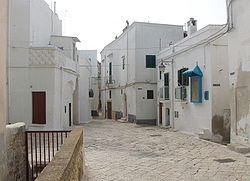Castellaneta
Castellaneta
Comune in Apulia, Italy
Castellaneta (Tarantino: Castelanéte) is a city and comune in the province of Taranto in the Apulia region of Southern Italy, about 40 km (25 mi) from Taranto. Located in a territory spanning from the Murgia to the Ionian Sea, characterized by numerous gravina (ravines), it is part of the Comunità Montana della Murgia Tarantina (Tarentine Murgia Mountain Community).
You can help expand this article with text translated from the corresponding article in Italian. (July 2012) Click [show] for important translation instructions.
|



